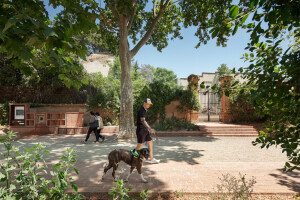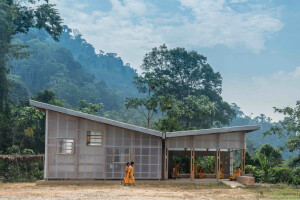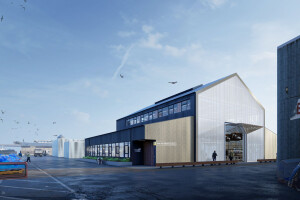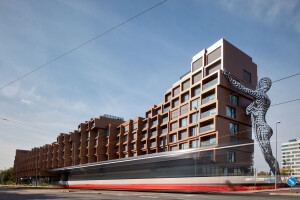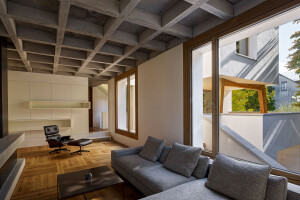Attractive experience & animal welfare It is the clients desire to offer new attractive experience to the visitors of the zoo. An experience where they are immersed, walking trough an African landscape with birds of prey flying over their heads and sitting in the canopy above them.
This perception, but also the welfare of animals requires a lot of space and the suggestion of space. In addition, the vultures throughout the year are outside, while for example during their breeding season the marabous should be kept from the sight of the public. Construction within the aviary should be limited or not be there at all and there are many requirements for breeding places. Besides warmth and shelter these should not look like "human" constructions in a natural habitat. Straight or sharp corners are not desirable in the aviary, for the birds could fly into these kind of corners and get stuck, and likely hurt themselves.
Because some of the birds stay all year outside, shelter should be provided as well as warm seating areas. This has to be done in a way that the birds experience their comfort while visitors can not see the amenities.
Performance and image This aviary and bird holding should be implemented in stages so as to minimize disruption to the zoo and for the public. Maintenance on the building should be minimal. The building must be consistent with the ideology and the image of the zoo regarding animal welfare and enhance sustainability. Furthermore, the design must fit it to the zoo themed continent: Africa.
The new cage is positioned on a long narrow lot next to the track. It should serve both the zoo-visitors and appeal to passing rail-passengers.These rail-passengers pass here after they have passed many backsides of buildings and sites on their way to the center of the city. They are also potential visitors.
Holistic Architecture The architecture of the aviary follows that of the slightly more distant African savannah house, a wooden structure of ribs, thus reinforcing the African atmosphere in this 'continent' of the zoo. The savannah house is a little further down and away from the track than the aviary. The aviary is also specifically tailored for that spot right along the track. The plot tapering down pushes as it were the ends of the curved ribs toward each other, making the arcs rising into the air, this provides the birds more flying space and creates a natural separation between the different species, which reduces stress. The vultures like to sit high, the marabous are more likely to be seen on the ground. The Southern Ground Hornbill will find its way some where in-between.
The arches not only create an interesting economic structure, there are also no columns in the landscape and there are no straight or sharp angles. This gives the birds more space for their movements and there is no danger to the clamp-fly in comparison to a rectangular shaped aviary.
The arches also contribute to the suggestion of space by not having edges as rectangular aviaries are known to have. These at the edges where wall and roof meet to roof. Because of the distance the mesh is often not visible for the visitors. But it is precisely those edges that immediately mark the boundaries of a aviary and that is affecting the perception of spaciousness. The arches help blurring the boundaries between inside and outside the aviary together with a good plan of planting in and outside the aviary.
The shelters and breeding places for the vultures are integrated in the south-facing façade for an optimum comfort for the birds and for a clean and natural African Landscape. These shelters are heated during wintertime and very easely maintained by the zookeepers. As mentioned earlier the marabous go inside during extreme cold times and during breading season. The ground hornbill will find its shelter inside and outside. Outside the are placed in hollow trees.
Train travellers The train track is situated three meters above the aviary landscape. Every day thousands of travellers pass here on their way to the central station of the city. The aviary stands as it where in the showcase of the zoo. Just at the point where the train prepares to enter the station and starts slowing down this is where the eye of the travellers meets the zoo. The varying height of the arches gives a sculptural shape to the aviary and rhythm. Being an eye catcher, its aims to attract the travellers attention to the entrance of the city and gives a suggestion of the special meetings that may be found in the zoo.
Sustainability The bird holding between the two habitats, is heated and cooled by south-west facing facade. It is a so-called energy-generating climate facade. This facade collects power and is able to heat water and air due to absorbing the free warmth and radiation of the sun. It also is able to cool air through a simple system witch is based on natural principles and trough a connection witch heat / cold storage in the soil. Since ventilation is also based on natural principles the building is a breathing by itself. All of this is not only interesting for the operational costs during the next thirty or fifty years, it is also easy to use and maintain an off course very durable. But above all it creates a pleasant indoor regulated climate for the animals. Through the link with heat / cold storage it is possible to heat even on the days when the sun is behind the clouds. When there is to much capacity the heat or cold can also transported, in the nearby future, to nearby residents/habitats. Because of the use of rapidly renewable materials and the energy-generating design, this aviary has a minimal footprint and seamlessly connects with the ambition of the Zoo. The chosen materials are consistent with those of the Savannah House and thus makes a perfect fit in the atmosphere of this Africa-section of the zoo.
Planning The bird holding is the separation between the first and second phase. Therefore the program can be cut dramatically as well as financially. But it also ensures that visitors are least hindered by the construction, now and later. By making the entire building prefab the building time is also greatly reduced. This too benefits the zoo and its visitors and the animals living in the surrounding arias. Moreover, is creates also more time to shape the African landscape within and around the aviary.
Facts: Dimensions 1st aviary: 50m (length)x 25m (wide) x 14m(height) meter - residents: Ruppel vultures, Marabous, Southern Ground Hornbill Dimensions bird holding (indoor stay): 21m (length)x 18m (wide) x 11m(height) – residents: Marabous and various small African birds and African mammals Dimensions 2nd aviary: 65m (length)x 17m (wide) x 9m(height) meter L65xB17xH9 various African mammals






















